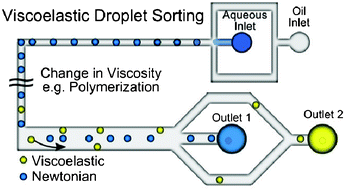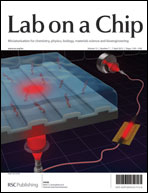Passive droplet sorting using viscoelastic flow focusing†
Abstract
We present a study of passive hydrodynamic droplet sorting in microfluidic channels based on intrinsic viscoelastic fluid properties. Sorting is achieved by tuning the droplets' intrinsic viscous and viscoelastic properties relative to the continuous oil phase to achieve a positive or negative lateral migration toward high or low shear gradients in the channel. In the presence of weakly viscoelastic fluid behavior, droplets with a viscosity ratio, κ, between 0.5–10 were found to migrate toward a high shear gradient near the channel walls. For all other κ-values, or Newtonian fluids, droplets would migrate toward a low shear gradient at the channel centerline. It was also found that for strongly viscoelastic fluids with low interfacial tension, droplets would migrate toward the edge even with κ-values lower than 0.5. The resulting bi-directional lateral droplet migration between different droplets allows size-independent sorting. Still, their sorting efficiencies are dependent on droplet size, intrinsic fluid elasticity, viscosity, droplet deformability, and overall fluid shear rates. Based on these findings, we demonstrate >200 Hz passive droplet sorting frequencies and achieve >100 fold enrichment factors without the need to actively sense and/or control active mechanisms. Using a low viscosity oil phase of 6.25 cPs, we demonstrate sorting discrimination of 1 cPs and 5 cPs aqueous droplets with κ-values of 0.2 and 0.8 respectively.


 Please wait while we load your content...
Please wait while we load your content...